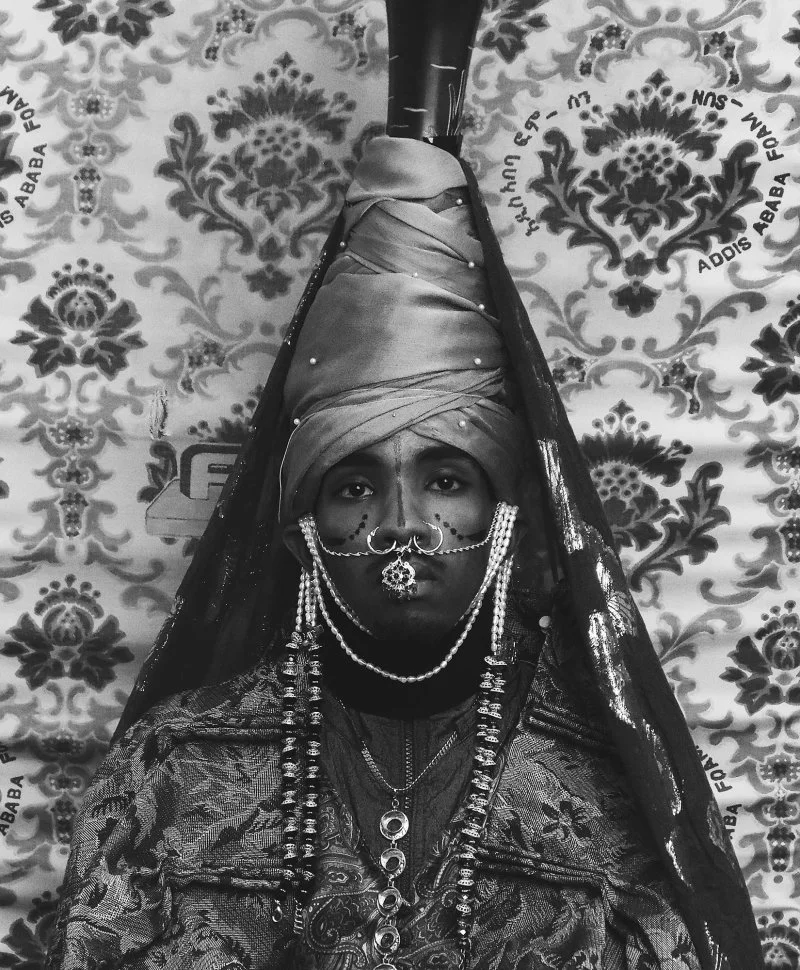Africa Fashion | Brooklyn Museum
“Chasing Evil” collection, IAMISIGO, Kenya, Autumn/Winter 2020. Courtesy IAMISIGO. (Photo: Maganga Mwagogo)
Text: Eloise King-Clements
In 1957, the Prime Minister of Ghana, Kwame Nkrumah, stepped onto a stage to greet his newly independent people. The Gold Coast became Ghana, and joyfully they lowered the British flag and raised their newly minted one. Before Nkrumah spoke, however, he signaled to the cheering crowd and the world at large, his pride for his heritage and the new identity Ghana was stepping into. How did he say this to his people? In sartorial taste. He wore kente cloth, a Ghanaian woven textile, in a design that meant “Adwini asa,” translated to “I have done my best” which spoke a thousand words—to forego the European tailor suit, and instead step into a design of Ghana, he signified to his people his embrace of authentic Ghana identity and unity.
Gouled Ahmed (born Djibouti, 1992). Self-Portrait, Addis Foam, Ethiopia, 2017. Courtesy of the artist.
Africa Fashion, the exhibit at the Brooklyn Museum, evokes a certain hesitation. The name, a sweeping proclamation of an entire continent of fashion, makes you wonder if they bit off more than they could chew. But after viewing it with much anticipation—the first iteration of the exhibit was initially unveiled across the pond at the V&A—the sprawling exhibition is, without a doubt, a triumph.
On the ground floor of the Brooklyn Museum, gliding doors usher you into African Fashion with context. The entrance, a corridor with spotlit turquoise walls, offers a long timeline of African countries’ independent movements. Many of the ticks on the timeline center around 1960, dubbed, “The Year of Africa,'' as 17 countries dispelled colonial rule, and Africa took their rightful place as a major force in the United Nations. They supplement the history with projections of footage, and magazines like Ebony inside shiny vitrines.
Photo by Lakin Ogunbanwo, image courtesy of Nataal
The exhibition is an exercise in nuance: it highlights the individual identities of each country (for example, the Àdìrẹ cloth, an indigo dyed textile, became a celebrated symbol of Nigerian independence, even as the cloth was popularized internationally), yet the exhibit also champions Pan-Africanism—a movement for cultural unity throughout Africa, to embrace the countries similarities which boosted drive for liberation throughout the continent. The exhibition does not dismiss the playful and fun side of fashion: mannequins donned in glitzy and chic ensembles (from Shade Thomas-Fahm, Eilaf Osman, Christopher John Rogers, to name a few), but it also weaves in the political and social implications of fashion. As countries were liberated, fashion played a critical role in decolonizing the economies through manufacturing inside the country, and minds, as people shed their imported western clothing for designs authentic to their culture. The fashion industry projected power and confidence to the world. It’s a tall order to communicate these nuances inside an exhibit—a place where individuals can roam free, peruse at their leisure, but Africa Fashion manages it with ease. The exhibition “actively complicates what people assume African Fashion might be,” says Annissa Malvoisin, who co-curated theexhibition with Ernestine White-Mifetu.
Design by Chris Seydou. © Nabil Zorkot
For photography, we get a chunk. The exhibit is scattered with fashion images—by the entrance you are greeted by four prints of Drum cover girls, the anti apartheid magazine, shot by Jurgen Schadeberg, a German-born South African photographer, dubbed the “father of South African photography”. From the early 1970’s we see big prints from J.D. ‘Okhai Ojeikere, a Nigerian photographer, whose works look at elaborate Nigerian hairstyles. The photographs reimagine traditional portraiture by toying with the mainstays of a portrait: a face.
The exhibition features ten family photographs of self-fashioning. Gathered from the 50s to the 80s, the prints are anything but shabby family photos. The faded and cracked prints remain regal. One image depicts a girl sitting on a studio floor, her tailored gown splayed around her, and from her poise, to her bell sleeves, to her Afro and hoop earrings, the image arrests you with its soft grace. The photographs are intimate portraits of Black Power.
African National Congress (ANC) Nelson Mandela commemorative cloth, South Africa, 1991. (Photo: © Victoria and Albert Museum, London)
The show includes a long hallway of studio fashion photography and the transition from B&W to color (and the racial bias encountered with Kodak’s “Shirley” card”). The array centers around fashion photographers that focus on the performance of identity—small apertures capture the details of a piercing, the embellishment of a hemline. Trevor Stuurman, an South African photographer, shows Mama Panther, 2017, a gilded popping portrait that rejoices in the mixed reds and pinks of the dress as much as it cherishes the careful act of photography. Daniel Obasi, the Nigerian photographer, displays his work Parables (2022)—a gleaming black body held in billowing red fabric.
The clothes were never just clothes: they served as an entrance point into African cultural unity, and as countries across the continent were liberated, fashion was paramount to decolonize their minds, and step into their cultural identity.












